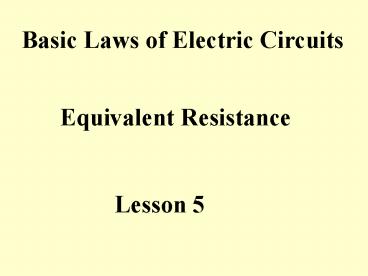Basic Laws of Electric Circuits PowerPoint PPT Presentation
1 / 26
Title: Basic Laws of Electric Circuits
1
Basic Laws of Electric Circuits
Equivalent Resistance
Lesson 5
2
Basic Laws of Circuits
Equivalent Resistance
We know the following for series resistors
Figure 5.1 Resistors in series.
Req R1 R2 . . . RN
1
3
Basic Laws of Circuits
Equivalent Resistance
We know the following for parallel resistors
Figure 5.2 Resistors in parallel.
2
4
Basic Laws of Circuits
Equivalent Resistance
For the special case of two resistors in parallel
Figure 5.3 Two resistors in parallel.
3
5
Basic Laws of Circuits
Equivalent Resistance
Resistors in combination.
By combination we mean we have a mix of series
and Parallel. This is illustrated below.
Figure 5.4 Resistors In Series Parallel
Combination
To find the equivalent resistance we usually
start at the output of the circuit and work back
to the input.
4
6
Basic Laws of Circuits
Equivalent Resistance
Resistors in combination.
Figure 5.5 Resistance reduction.
5
7
Basic Laws of Circuits
Equivalent Resistance
Resistors in combination.
6
Figure 5.6 Resistance reduction, final steps.
8
Basic Laws of Circuits
Equivalent Resistance
Resistors in combination.
It is easier to work the previous problem using
numbers than to work out a general expression.
This is illustrated below.
Example 5.1 Given the circuit below. Find Req.
Figure 5.7 Circuit for Example 5.1.
7
9
Basic Laws of Circuits
Equivalent Resistance
Resistors in combination.
Example 5.1 Continued
We start at the right hand side
.
of the circuit and work to the left.
Figure 5.8 Reduction steps for Example 5.1.
Ans
8
10
Basic Laws of Circuits
Equivalent Resistance
Resistors in combination.
Example 5.2
Given the circuit shown below. Find Req.
Figure 5.9 Diagram for Example 5.2.
9
11
Basic Laws of Circuits
Equivalent Resistance
Resistors in combination.
Example 5.2
Continued.
Fig 5.10 Reduction steps.
10
12
Basic Laws of Circuits
Equivalent Resistance
Resistors in combination.
Example 5.2
Continued.
10 ? resistor shorted out
Req
Fig 5.11 Reduction steps.
11
13
Basic Laws of Circuits
Equivalent Resistance
Resistors in combination.
Example 5.2
Continued.
Req
Fig 5.12 Reduction steps.
Req
12
14
Basic Electric Circuits
Wye to Delta Transformation
You are given the following circuit. Determine
Req.
Figure 5.1 Diagram to start wye to delta.
13
15
Basic Electric Circuits
Wye to Delta Transformation
You are given the following circuit. Determine
Req.
Figure 5.13 Diagram to start wye to delta.
14
16
Basic Electric Circuits
Wye to Delta Transformation
We cannot use resistors in parallel. We cannot
use resistors in series. If we knew V and I we
could solve
V
Req
I
There is another way to solve the problem without
solving for I (given, assume, V) and calculating
Req for V/I.
15
17
Basic Electric Circuits
Wye to Delta Transformation
Consider the following
Figure 5.14 Wye to delta circuits.
We equate the resistance of Rab, Rac and Rca of
(a) to Rab , Rac and Rca of (b) respectively.
16
18
Basic Electric Circuits
Wye to Delta Transformation
Consider the following
R2(R1 R3)
Eq 5.1
Rab Ra Rb
R1 R2 R3
R1(R2 R3)
Eq 5.2
Rac Ra Rc
R1 R2 R3
R3(R1 R2)
Eq 5.3
Rca Rb Rc
17
R1 R2 R3
19
Basic Electric Circuits
Wye to Delta Transformation
Consider the following
Eq 5.4
Eq 5.5
Eq 5.6
18
20
Basic Electric Circuits
Wye to Delta Transformation
Observe the following
Go to delta
Go to wye
Eq 5.4
Eq 5.5
Eq 5.6
We note that the denominator for Ra, Rb, Rc is
the same. We note that the numerator for R1, R2,
R3 is the same. We could say Y below D
19
21
Basic Electric Circuits
Wye to Delta Transformation
Example 5.3 Return to the circuit of Figure
5.13 and find Req.
a
c
b
Convert the delta around a b c to a wye.
20
22
Basic Electric Circuits
Wye to Delta Transformation
Example 5.3 continued
Figure 5.15 Example 5.3 diagram.
It is easy to see that Req 15 ?
21
23
Basic Electric Circuits
Wye to Delta Transformation
Example 5.4 Using wye to delta. The circuit of
5.13 may be redrawn as
shown in 5.16.
a
c
b
Figure 5.16 Stretching (rearranging) the
circuit.
Convert the wye of a b c to a delta.
22
24
Basic Electric Circuits
Wye to Delta Transformation
Example 5.4 continued
a
a
c
c
b
b
(a)
(b)
Figure 5.17 Circuit reduction of Example 5.4.
23
25
Basic Electric Circuits
Wye to Delta Transformation
Example 5.4 continued
Figure 5.18 Reduction of Figure 5.17.
Req 15 ?
This answer checks with the delta to wye solution
earlier.
24
26
Basic Laws of Circuits
circuits
End of Lesson 5
Equivalent Resistance

